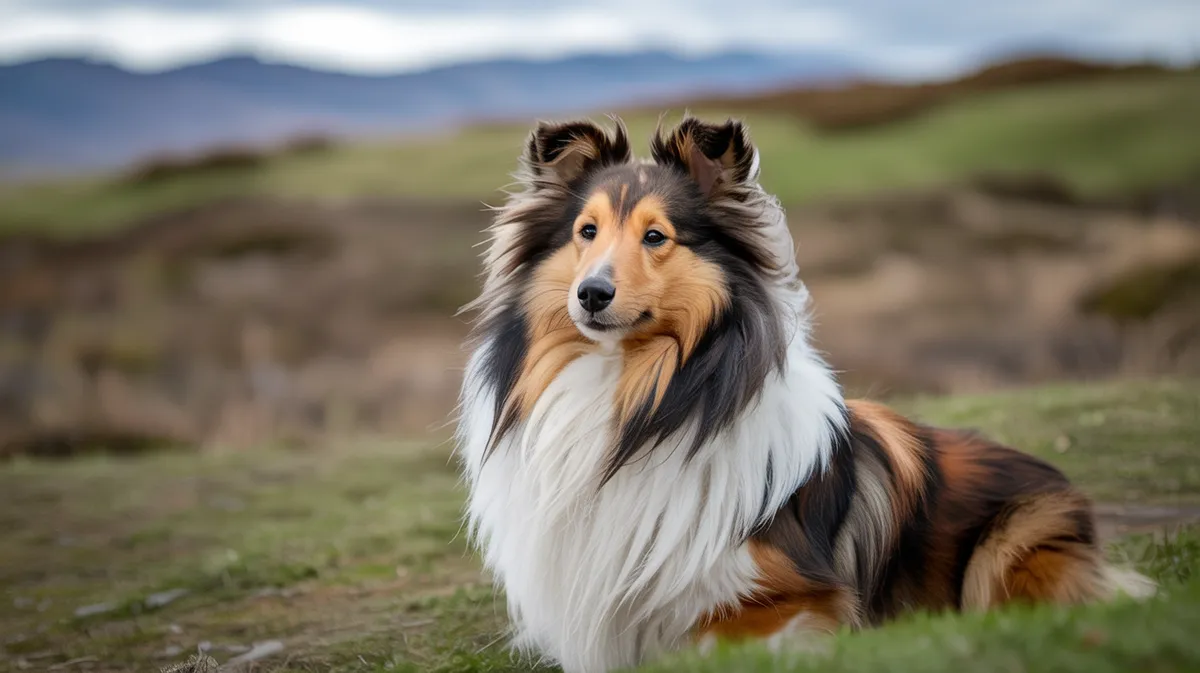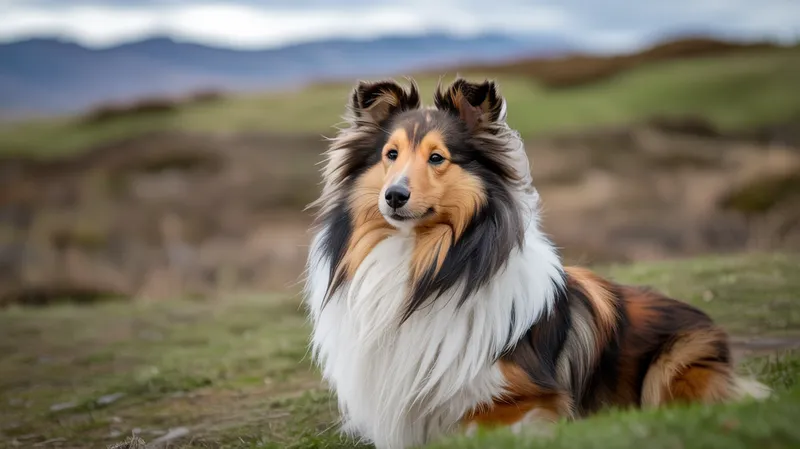
Shetland Sheepdog
Canis lupus familiaris

Meet the Shetland Sheepdog
The Shetland Sheepdog, often affectionately called the 'Sheltie', is a small to medium-sized herding breed originating from the Shetland Islands of Scotland. Renowned for its intelligence, agility, and striking resemblance to a miniature Rough Collie, the Sheltie is highly trainable and excels in various dog sports. Its dense double coat provides protection against harsh weather, while its alert and loyal nature makes it a popular companion animal. Shelties are known for their keen herding instincts and are often described as energetic, responsive, and affectionate with their families.
Classification
Mammal
Habitat
Domesticated; originally adapted to rural and coastal environments
Diet
Omnivore
Lifespan
12-14 years
Conservation
Least Concern
Weight
6-12 kg
📖Fascinating Facts
Miniature Herding Dog
The Shetland Sheepdog was originally bred to herd sheep and protect crops on the rugged Shetland Islands.
Highly Intelligent
Shelties are ranked among the top dog breeds for intelligence and obedience, learning new commands with remarkable speed.
Weatherproof Coat
Their thick double coat shields them from cold, wind, and rain, a necessity in the often harsh Shetland climate.
📋Detailed Description
The Shetland Sheepdog (Canis lupus familiaris), commonly known as the Sheltie, is a small, agile herding breed with a distinctive long, double-layered coat that offers excellent insulation against the harsh, windy climate of the Shetland Islands. Adult males typically stand 34.5–39.5 cm (14–16 in) at the shoulder, while females are slightly smaller at 33–38 cm (13–15 in), with weights ranging from 6 to 12 kg (13–26 lbs). The breed's wedge-shaped head, expressive almond-shaped eyes, and erect, tipped ears contribute to its alert and intelligent appearance. Shelties possess a well-muscled, athletic build, allowing for remarkable speed and agility, traits essential for their original role in herding sheep, ponies, and poultry. Their dense undercoat and longer, straight outer coat provide weather resistance and protection from brambles. Behaviorally, Shelties are highly responsive, eager to learn, and form strong bonds with their human families, often displaying a reserved demeanor toward strangers. They are known for their keen sense of hearing and vocal tendencies, frequently using barking as a means of communication or alert. Socially, Shelties thrive in structured environments and often excel in obedience, agility, and canine sports due to their intelligence and willingness to please. Reproductively, they are seasonal breeders with litters typically ranging from 4 to 6 puppies. Unique adaptations include their herding instinct, which manifests as circling or nipping behaviors, and their ability to interpret subtle cues from both livestock and humans.
💡 Did you know?
The Sheltie’s long, luxurious coat is weather-resistant and was developed to protect them from the harsh winds and rain of the Shetland Islands.
🔬Research & Sources
Wikipedia Summary
The Shetland Sheepdog, also known as the Sheltie, is a breed of herding dog that originated in the Shetland Islands of Scotland. It was formally recognized by the Kennel Club in 1909. It was originally called the Shetland Collie, but this caused controversy amongst Rough Collie breeders of the time, so the name was changed. It is a small dog, clever, vocal, willing to please, and trustworthy.
Last Modified: 1/30/2025
🎭Behavior & Social Structure
Shetland Sheepdogs are highly active and intelligent, requiring regular mental and physical stimulation. Their herding ancestry is evident in their tendency to gently herd children, other pets, or even adults by circling or nudging. Shelties are known for their strong attachment to family members and may develop separation anxiety if left alone for extended periods. They are alert and quick to respond to environmental changes, making them excellent watchdogs, though their vocal nature can lead to excessive barking if not managed. Feeding behavior is typical of domesticated dogs; they thrive on a balanced omnivorous diet and may be prone to weight gain if overfed or under-exercised. Social interactions are generally positive with familiar humans and animals, but Shelties can be reserved or cautious around strangers, a trait likely selected for in their original working environment. Daily routines should include structured play, training sessions, and opportunities for exercise to prevent boredom and behavioral issues.
👶Reproduction & Life Cycle
Shelties reach sexual maturity between 6 and 12 months, though responsible breeding is typically delayed until at least 18 months of age. The breed is monoestrous, with females coming into heat once or twice a year. Mating is usually planned to coincide with optimal health and age of the dam. Gestation lasts approximately 63 days, after which litters of 4–6 puppies are born. Neonatal care is intensive, with the dam providing warmth, nutrition, and grooming. Breeders often assist with early socialization, exposing puppies to various stimuli to encourage confident temperaments. Weaning begins at 3–4 weeks, and puppies are typically ready for new homes at 8–10 weeks. The breed is susceptible to certain inherited conditions, such as Collie Eye Anomaly and hip dysplasia, so ethical breeders screen for these prior to mating.
🛡️Adaptations & Survival
The Sheltie’s dense double coat is a key adaptation, providing insulation against cold, wet, and windy weather typical of the Shetland Islands. Their compact size and agility allowed them to maneuver easily over rocky, uneven terrain while herding livestock. The breed’s acute hearing and keen eyesight are evolutionary advantages for detecting predators or stray animals. Behaviorally, their intelligence and trainability are products of selective breeding for complex herding tasks, while their reserved nature with strangers likely reduced the risk of livestock theft. Their vocal tendencies served as an early warning system for both flock and farmer. Additionally, Shelties display a strong instinct for pattern recognition and problem-solving, essential for managing unpredictable livestock movements.
📚Research Sources
🎨Cultural Significance
The Shetland Sheepdog holds a prominent place in Scottish rural culture, historically valued for its versatility in herding sheep, ponies, and poultry on small crofts. Its intelligence and trainability have made it a favorite in competitive dog sports, including obedience, agility, and herding trials worldwide. Shelties are frequently depicted in literature and media as loyal, clever companions, reinforcing their reputation as family-friendly pets. While not associated with specific myths or folklore, their resemblance to the larger Rough Collie has contributed to their popularity, especially following the fame of Lassie. In modern times, Shelties are also employed as therapy and assistance dogs due to their gentle disposition and responsiveness.
🔬Recent Research & Discoveries
Recent genetic studies have clarified the Sheltie’s close relationship to the Rough Collie and other British herding breeds, with evidence of historical crossbreeding to enhance working ability and coat quality. Ongoing research focuses on the identification and management of inherited diseases, particularly Collie Eye Anomaly and MDR1 gene mutation, which affects drug sensitivity. Behavioral research highlights the breed’s exceptional trainability and cognitive abilities, making them a model for studies on canine learning and communication. Studies on canine longevity indicate that Shelties have a median lifespan of 12–14 years, with proper care and health screening contributing to longevity. Recent advances in canine nutrition and preventative veterinary care have further improved breed health outcomes.
🎥Wildlife Videos

The Unsung Hero of the Herding World: Shetland Sheepdogs
Join us on an unforgettable journey as we shine the spotlight on the Shetland Sheepdog, the unsung hero of the herding world.
Dogumentary TV

Shetland Sheepdogs
Scotland July 2017.
Richard Bateman Jr

Sheltie Dog Mingling with Chicken Flock Animals
This video shows the first time my 5 year old female Sheltie Dog is let loose mingling with my Chicken flock of 5 Hens, 1 Barred ...
René Feuerlein

Shetland Sheepdog - Top 10 Facts (Sheltie)
The Shetland Sheepdog, often known as the Sheltie, is a breed of herding dog that originated in the Shetland Islands of Scotland.
Dogs Wiz

Female Sheltie Dog Totally Fascinated by Chickens
Shot this video of my five year old female Sheltie (Shetland Sheepdog) Noelle, totally fascinated by two, out of five, of my Chickens ...
René Feuerlein
🌍Habitat Information
The Shetland Sheepdog typically inhabits Domesticated; originally adapted to rural and coastal environments environments. Shetland Sheepdogs have adapted to their environments with specialized features and behaviors.
Primary Habitat:
Domesticated; originally adapted to rural and coastal environments
More detailed habitat information will be available soon.
🛡️Conservation Status
The Shetland Sheepdog is currently classified as Least Concern. Conservation efforts are crucial for preserving this species for future generations.
Common Threats:
- 🏠Habitat loss and fragmentation
- 🌡️Climate change impacts
- 🎯Hunting and poaching
- 🏭Human-wildlife conflict
⚠️Threats & Conservation Challenges
As a domesticated breed, Shetland Sheepdogs are not threatened in the wild, but they face challenges related to genetic health and responsible breeding. Overbreeding and popularity have led to an increased incidence of hereditary diseases such as Collie Eye Anomaly, progressive retinal atrophy, and dermatomyositis. Modern lifestyles may not always provide the mental and physical stimulation Shelties require, leading to behavioral problems. There is also a risk of abandonment or surrender to shelters if owners are unprepared for the breed’s activity level and grooming needs. Conservation of genetic diversity within the breed is an ongoing concern among reputable breeders. Population trends remain stable, with the breed maintaining popularity as a companion and performance dog.
🔬Scientific Classification
Scientific Name
Canis lupus familiaris
Classification Hierarchy
🔍 About Taxonomic Classification
Taxonomic classification is a hierarchical system used by scientists to classify and organize living organisms based on shared characteristics and evolutionary relationships.
The system moves from broad categories (Kingdom) to increasingly specific ones, with each animal's scientific name typically consisting of its Genus and species.
📝Community Notes
Share your observations and insights about the Shetland Sheepdog with our community of wildlife enthusiasts.
Join Our Community
Sign in to share your observations and connect with fellow wildlife enthusiasts.
Sign In to ContributeNo community notes yet
Be the first to share your observations about the Shetland Sheepdog!
Explore Shetland Sheepdog
Select a tab above to learn more about this amazing animal.
📸Photo Gallery
No photos available for this animal yet.
🌟Discover More Wildlife
Continue your journey of discovery with more fascinating animals from our database
